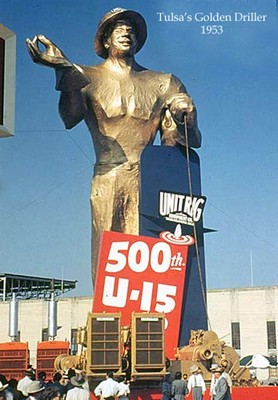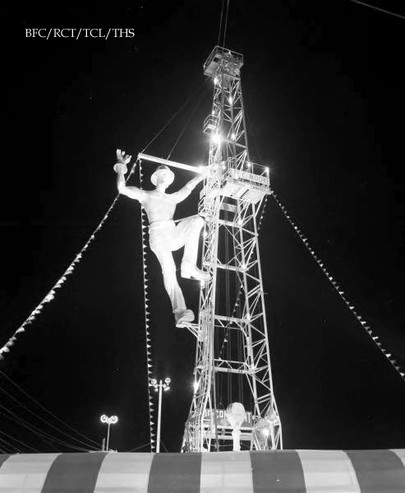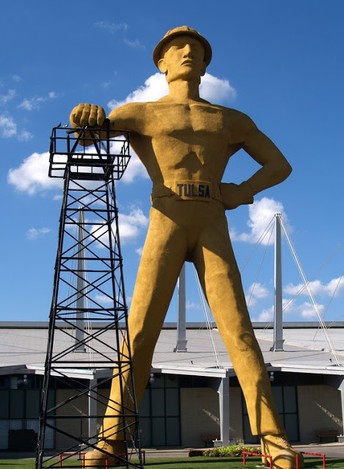Tulsa's Golden Driller
Introduction
Text-to-speech Audio
Images
1953 Driller, courtesy of Tulsa Gal.

1959 Driller, courtesy of Tulsa Gal.

Today's Driller, courtesy of Tulsa Gal.

Backstory and Context
Text-to-speech Audio
Tulsa's Golden Driller cuts an impressive figure. Weighing in at 43,500 lbs of concrete, plaster, and 2.5 miles of steel mesh, this wildcatter stands 76 feet tall. His hard hat size is 112, his shoe size is 393DDD, his belt size is 48 ft, and he is the fifth tallest statue in the United States. The Driller has had several incarnations over the years, with the first appearing in 1953. He was built by the Mid-Continent Supply Company of Fort Worth for the International Petroleum Exposition, which took place Tulsa that year. The 1959 Driller looks not unlike a trophy, and he seems to be making an “okay!” sign with his right hand, in a nod to the state hosting the exhibition. He was a huge hit with the expo attendees and the city of Tulsa. But alas, the 1959 Driller was a temporary installation, and he was removed after the expo ended.
The overwhelmingly positive audience response to the Driller prompted Mic-Continent Supply Co. bring him back for the 1959 expo, albeit in a drastically altered form. The 1959 Driller was sleek, angular, chiseled, and posed in the motion of climbing an oil derrick, not unlike King Kong climbing the Empire State building. Again, the audiences loved the Driller. So much so, that Mid-Continent donated it to the Tulsa County Fairgrounds which hosted the IPE. Once more, the Driller was deconstructed and stored until the next exposition.
The final version of the Driller was installed for the 1966 IPE. Again, he had changed. The Driller had kept his sleek, chiseled, angular features, but rather than climbing wildly to reach the top, this Driller stood solidly beside an oil derrick, with his arm draped across the top in a casual gesture of conquest and mastery. This time, the structure was an actual oil derrick from Seminole, OK, which was decommissioned after the oil field it resided in went dry. The Driller, like the Tulsa petroleum industry, had matured. A commemorative plaque was installed at the base of the new statue. The inscription reads: "The Golden Driller, a symbol of the International Petroleum Exposition. Dedicated to the men of the petroleum industry who by their vision and daring have created from God's abundance a better life for mankind." Tulsa's Golden Driller was adopted by the Oklahoma Legislature as the state monument in 1979.
As far as stationary landmarks go, the Golden Driller has been among the most interactive landmarks in history. Local businesses have festooned him with ties, belts, and hatbands. Local media outlets and charity groups have draped the Driller in custom-designed T-shirts. Of course, the Golden Driller has also had his share of upsets. Tornadoes, shotgun blasts, and flat-out neglect have intermittently plagued the stoic roughneck, but since the 1979 refurbishment of the Driller, Tulsa County has maintained preservation efforts to keep the iconic landmark in good shape. In 2011, Bill Haynes Company repaired and repainted the Driller, patching the plaster and concrete dents and refreshing his golden hue before applying a waterproof, “lifetime” coating of protective sealant.
